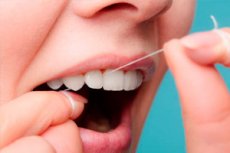New publications
Vaccination without a needle: Scientists propose a new method with dental floss
Last reviewed: 27.07.2025

All iLive content is medically reviewed or fact checked to ensure as much factual accuracy as possible.
We have strict sourcing guidelines and only link to reputable media sites, academic research institutions and, whenever possible, medically peer reviewed studies. Note that the numbers in parentheses ([1], [2], etc.) are clickable links to these studies.
If you feel that any of our content is inaccurate, out-of-date, or otherwise questionable, please select it and press Ctrl + Enter.

Flossing your teeth at least once a day is an important part of any hygiene routine. But one day, it may protect other parts of the body, too: Scientists have created a new, syringe-free vaccination method using special dental floss.
In a study published in Nature Biomedical Engineering, the scientists showed that when a thread impregnated with vaccine components (such as proteins or inactivated viruses) was passed along the gums of mice, it triggered an immune response.
This method of vaccine delivery has proven effective because the gum area between the teeth is highly permeable and easily absorbs vaccine molecules.
Flossing mice
In the experiment, the researchers flossed 50 mice every two weeks for 28 days, which proved to be a difficult task. To clean each mouse's teeth, one person had to gently pry open its jaw with a metal key ring while another person flossed.
Four weeks after the final dose of vaccine, the mice were exposed to a deadly strain of influenza. All the rodents that received the floss vaccine survived, while the unvaccinated animals died. In addition, the mice that had their teeth flossed had a broader immune response throughout their bodies. Flu antibodies were found in their feces, saliva, and even bone marrow.
The presence of antibodies in the bone marrow indicates that the mice had developed a long-term immune response. The researchers also recorded increased levels of T cells (immune cells that fight infections) in the lungs and spleens of the mice.
Next step: people
The researchers then wanted to see if the approach would work in humans. They asked 27 healthy volunteers to brush their teeth with food coloring-coated toothbrush sticks. On average, the dye reached the gums about 60 percent of the time.
Overcoming obstacles
The mouth and nose are the primary entry points for many viruses, making the oral cavity an ideal location for vaccine delivery. However, scientists have faced significant challenges in developing syringe-free alternatives for these areas due to the body’s strong defenses against foreign substances. The dental floss approach may bypass these barriers, offering a promising new method.
"These results confirm that dental floss vaccination is a simple, syringe-free strategy that improves vaccine delivery and immune activation compared with existing mucosal immunization methods," the researchers wrote.
This innovative method of vaccine delivery offers a number of additional benefits. One of the most compelling is the potential to increase vaccination coverage, especially among people who are afraid of needles. In addition, dental floss-based vaccines do not require special storage conditions and cold-weather transportation. They can be easily delivered by mail, which will be useful for rapid mass vaccination during pandemics.
